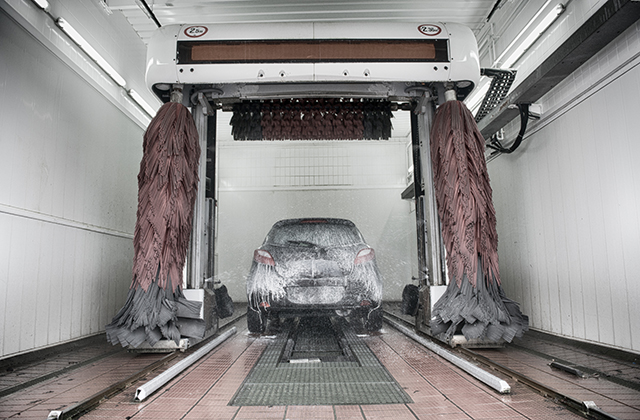While most people are careful with regular maintenance and tune-ups, car washing can sometimes be overlooked. Weekly car washes can not only make your vehicle look better, they can make your vehicle last longer. We specialize in high quality car wax to protect and preserve your investment on the outside plus cutting edge car care products. However, there is a right way to wash your car – and many wrong ways to do it. At Meineke, we want to help our customers properly maintain their vehicles and save money. Not using the proper soap, equipment or technique can do more harm than good. Here’s what you need to know:
Can You Use Dish Soap to Wash a Car?
A common question is: can you wash your car with dish soap? Think about what dish soap is for: removing grease and caked-on food. While it does a good job at that, it’s good because it’s considered an abrasive soap. But, when you use an abrasive soap on something like car paint, it accelerates the oxidation process and gives the car a dull look. Dish soap will also break down a car’s wax coat and can be tough on rubber.
What Makes a Good Car Soap?
Now that you know not to use dish soap to wash a car, what does that leave you with? Laundry soap, hand soap and other household cleaners are also off limits. These soaps are not pH balanced and can also damage your vehicle’s paint. To get the results you want, you’ll simply need car soap. Car soap contains more lubricant, which you’ll notice when you move it behind your fingers. The slick formula is much better for your car’s surface.
What Other Products Will You Need Besides Car Soap?
- Sponge or Washing mitt made of sheepskin or microfiber
- A brush or additional sponge for tires
- Multiple buckets – one for soapy water and one for plain water
- Wheel cleaner
- Microfiber drying towel, shammy, and/or squeegee
- Bug and tar remover
- Wax, either spray or rub-on (optional)
- Polish (optional)
What Should You Know Before Starting?
- Always wash your car in the shade to avoid premature drying. Sunlight can create water
spots that stain your car. - Avoid water spots by keeping your car wet at all times.
- Make sure all windows and doors are shut, and don’t squirt water under the hood.
What’s the Proper Way to Wash a Car?
These steps and strategies will ensure you get the best results:
- Wash the wheels first. The wheels will be extremely dirty and require the most scrubbing. When you’re finished, refill your buckets with fresh soap and water.
- Rinse off your entire car with a hose, making sure you get any debris out from underneath the wiper blades.
- Pre-treat any stains (bugs, bird droppings) by applying bug and tar removal soap directly to the stain.
- Start soaping one side of the car. Make sure to periodically rinse off the mitt in the water bucket to avoid accumulating dirt.
- Avoid scrubbing too hard and wash in straight lines. Circular motions can create swirl marks.
- Rinse off the side you’re working on prior to soaping up the next side.
- Once you wash all four sides of your car, you still need to make sure to dry your car properly.
Can You Air Dry a Car?
Air drying after washing can create water spots. Carefully dry your car by using a car squeegee to remove most of the water. After that, use a microfiber towel over everything. The towel should be flat and moved in straight lines, no circular motions.
Should You Use Polish and/or Wax?
Polish or wax should only be used after a car is washed and completely dry. Polish adds shine, while wax protects the car’s paint. If water doesn’t bead into droplets on your car’s surface, it needs another wax coat. Waxes are only effective when used with proper car soap. The question often comes up when people are upset that their waxing product only lasts a couple weeks. You should only need to do seasonal waxing if you use car soap. Stop by your local Meineke Car Care Center if you have any questions about car cleaning products or techniques.
